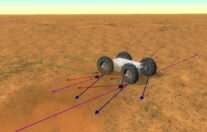Some important news before we begin. To make sure reading our updates is worth your time, we'll only be covering major milestones and achievements from now on. In other words we'll be tuning down the frequency of blog updates. You can expect a blog post every two weeks for now.
Handling the Force
Together with your input we decided to use realistic physics for Planet Nomads. In other words, what you know from real life will apply for Planet Nomads as well, with the difference of different gravity on each planet and no gravity in space. For Planet Nomads this means taking all the magical and rather complex physics formulae and simplifying them just about the right amount to feel real while at the same time requiring simple enough calculations for your computer to handle them in real time. A very complicated thingie, as you can imagine. We'll start with creating physics for driving, as it feels most important and obviously most fun.
Drive It Like You Stole It
As any decent driver knows, driving in style is not about going straight as fast as you can. It's about hitting the curves right, about being squeezed to the seat when you accelaterate or make a sharp turn, it's about screeching of the wheels... Well, perhaps not on your everyday commute through town, but definitely something to be enjoyed in a game. Even more so when you are the designer of your ride. These sweet experiences are only possible thanks to the combination of gravity, tension, adhesion, centrifugal force, momentum, and all the other forces known to physics. The forces we'll work with are inlcuded in the picture below.
Different Ride Different Feel
The main factor of realistic feel when driving is actually friction. Tires will have different adhesion quality and therefore different types react differently under same conditions, some will stay on the track where others will "break" into drifiting. Your ride will also act differently when it's a 4-wheeler or 6-wheeler. More balanced weight distribution with 6-wheelers means it is less likely to get stuck in sand. Speaking of sand, specific terrain types, be that sand, gravel, dust or roads, will also affect the handling of your vehicle. Drive safely.
Wheels will "collide" with the environment and also objects. So besides using wheels for conventioanl riding, we're sure you'll put powered wheels to good use.
Images from left to right:
The arrows represent the forces used for simulated physics:
Turqoise - is the direction in which the wheel moves the vehicle (not magnitude)
Grey - the actual direction your vehicle is moving and the magnitude of the movement (velocity)
Green - Acceleration velocity
Red - Centripetal force - needed to balance the difference between where the wheel is actually going and where you want it to go.
Blue - Friction. Opposite force to the grey one. AKA Newton's Third Law of Motion
Magenta - the magnitude of friction
The Black Dot - Is the breaking point of friction being bigger than adhesion. AKA if the Magenta force get's past this point, the vehicle starts drifting.
When you assign a scientific job of grave importance to an engineer, this is the first thing he'll do.
Collision explained. Wall climbing machine blue-prints anyone?



![Planet Nomads [logo]](/wp-content/themes/planetnomads/resources/images/planetnomads.logo.png)






Leave a Reply